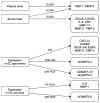The Comprehensive Analysis of Specific Proteins as Novel Biomarkers Involved in the Diagnosis and Progression of Gastric Cancer
- PMID: 37240178
- PMCID: PMC10218496
- DOI: 10.3390/ijms24108833
The Comprehensive Analysis of Specific Proteins as Novel Biomarkers Involved in the Diagnosis and Progression of Gastric Cancer
Abstract
Gastric cancer (GC) cases are predicted to rise by 2040 to approximately 1.8 million cases, while GC-caused deaths to 1.3 million yearly worldwide. To change this prognosis, there is a need to improve the diagnosis of GC patients because this deadly malignancy is usually detected at an advanced stage. Therefore, new biomarkers of early GC are sorely needed. In the present paper, we summarized and referred to a number of original pieces of research concerning the clinical significance of specific proteins as potential biomarkers for GC in comparison to well-established tumor markers for this malignancy. It has been proved that selected chemokines and their specific receptors, vascular endothelial growth factor (VEGF) and epidermal growth factor receptor (EGFR), specific proteins such as interleukin 6 (IL-6) and C-reactive protein (CRP), matrix metalloproteinases (MMPs) and their tissue inhibitors (TIMPs), a disintegrin and metalloproteinase with thrombospondin motifs (ADAMTS), as well as DNA- and RNA-based biomarkers, and c-MET (tyrosine-protein kinase Met) play a role in the pathogenesis of GC. Based on the recent scientific literature, our review indicates that presented specific proteins are potential biomarkers in the diagnosis and progression of GC as well as might be used as prognostic factors of GC patients' survival.
Keywords: DNA-based markers; MMPs; TIMPs; biomarkers; chemokines; gastric cancer; novel biomarker.
Conflict of interest statement
The authors declare no conflict of interest.
Figures


Similar articles
-
Identified a disintegrin and metalloproteinase with thrombospondin motifs 6 serve as a novel gastric cancer prognostic biomarker by bioinformatics analysis.Biosci Rep. 2021 Apr 30;41(4):BSR20204359. doi: 10.1042/BSR20204359. Biosci Rep. 2021. PMID: 33851708 Free PMC article.
-
Exploring Potential Biomarkers in Oesophageal Cancer: A Comprehensive Analysis.Int J Mol Sci. 2024 Apr 11;25(8):4253. doi: 10.3390/ijms25084253. Int J Mol Sci. 2024. PMID: 38673838 Free PMC article. Review.
-
The Role of Chemokines in the Development of Gastric Cancer - Diagnostic and Therapeutic Implications.Int J Mol Sci. 2020 Nov 10;21(22):8456. doi: 10.3390/ijms21228456. Int J Mol Sci. 2020. PMID: 33182840 Free PMC article. Review.
-
Gastric cancer - The role of matrix metalloproteinases in tumor progression.Clin Chim Acta. 2011 Sep 18;412(19-20):1725-30. doi: 10.1016/j.cca.2011.06.003. Epub 2011 Jun 14. Clin Chim Acta. 2011. PMID: 21693112 Review.
-
Matrix Metalloproteinases and Their Tissue Inhibitors in Comparison to Other Inflammatory Proteins in Gastric Cancer (GC).Cancer Invest. 2016 Aug 8;34(7):305-12. doi: 10.1080/07357907.2016.1197237. Epub 2016 Jul 14. Cancer Invest. 2016. PMID: 27414231 Review.
Cited by
-
Evaluation of a three-gene methylation model for correlating lymph node metastasis in postoperative early gastric cancer adjacent samples.Front Oncol. 2024 Oct 17;14:1432869. doi: 10.3389/fonc.2024.1432869. eCollection 2024. Front Oncol. 2024. PMID: 39484038 Free PMC article.
-
Integrated multidimensional bioinformatics analysis of the molecular mechanisms of ulcerative colitis-associated colorectal cancer and MMP1 as a potential therapeutic target.Cancer Gene Ther. 2025 Sep;32(9):973-984. doi: 10.1038/s41417-025-00917-5. Epub 2025 Jul 18. Cancer Gene Ther. 2025. PMID: 40681672
-
Serum Cystatin S (CST4): A Novel Prognostic Marker for Gastric Cancer.Clin Med Insights Oncol. 2025 Jan 6;19:11795549241311404. doi: 10.1177/11795549241311404. eCollection 2025. Clin Med Insights Oncol. 2025. PMID: 39776666 Free PMC article.
-
CLDN9 and hsa-miR-4496 as non-invasive biomarkers for gastric cancer detection.Discov Oncol. 2025 Apr 8;16(1):486. doi: 10.1007/s12672-025-02153-7. Discov Oncol. 2025. PMID: 40198459 Free PMC article.
-
Personalized Assessment for Cancer Prevention, Detection, and Treatment.Int J Mol Sci. 2024 Jul 26;25(15):8140. doi: 10.3390/ijms25158140. Int J Mol Sci. 2024. PMID: 39125710 Free PMC article.
References
-
- WHO [(accessed on 21 March 2023)]; Available online: https://gco.iarc.fr/today/data/factsheets/populations/900-world-fact-she....
Publication types
MeSH terms
Substances
Grants and funding
LinkOut - more resources
Full Text Sources
Medical
Research Materials
Miscellaneous

